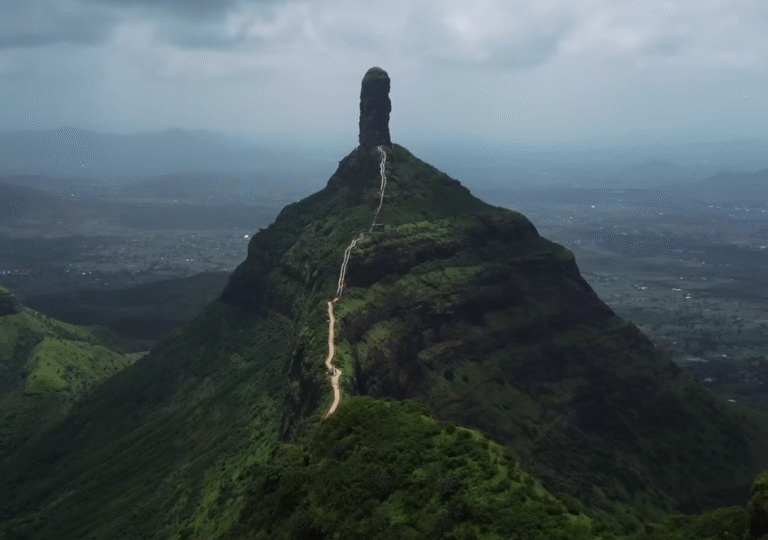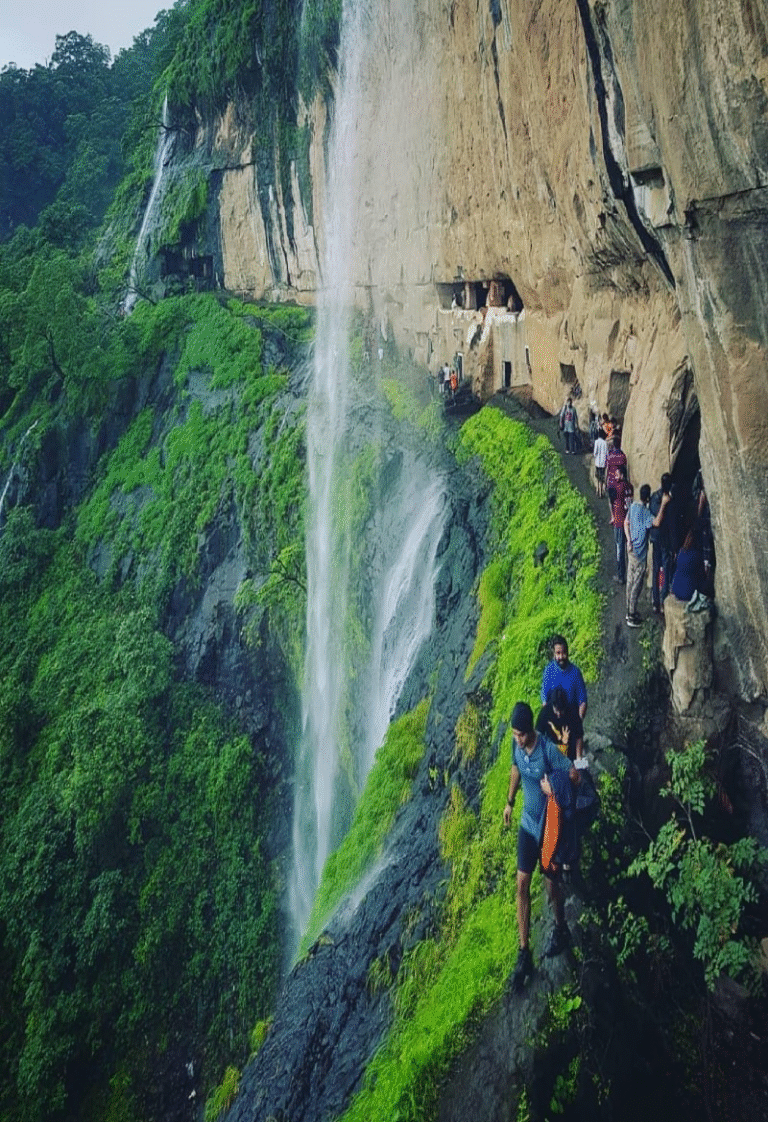
Alang Madan Kulang trek is a challenging and thrilling adventure, known for its demanding routes and breathtaking natural beauty. Here’s a comprehensive guide to help you plan your trek from Mumbai:
1. Overview of AMK Trek
- Difficulty Level: High. The trek involves climbing steep rock patches, dense forest trails, and requires good physical fitness.
- Duration: 3-4 days, depending on the pace and experience of the trekkers.
- Best Season: Post-monsoon (October to February) for the best weather conditions and clear views.
2. Getting to the Base Village from Mumbai
- By Train: Catch a train from Mumbai to Kasara. From Kasara, you can hire a local jeep or taxi to reach the base village Ambewadi or Udhewadi, which serve as starting points for the trek.
- By Road: Mumbai to Igatpuri or Kasara by road (via NH 160), and then towards Ghoti. From Ghoti, take the state road to reach the base village. The drive is scenic and takes approximately 4-5 hours.
3. Trekking Route and Details
- Day 1: Mumbai to Base Village
- Start early from Mumbai to reach the base village by late morning or early afternoon.
- Arrange for local guides if needed, as the trek can be challenging to navigate for first-timers.
- Acclimatize and prepare for the trek ahead.
- Day 2: Trek to Alang Fort
- Begin early towards Alang Fort. The climb involves navigating dense forests and steep rock patches.
- Explore Alang Fort, enjoy the panoramic views, and camp overnight at the cave or plateau on the fort.
- Day 3: Trek to Madan Fort
- Start the trek to Madan Fort early in the morning. This involves descending Alang and then climbing Madan, which has a more challenging rock face.
- After exploring Madan, return to the base of Madan or move towards Kulang for camping, depending on the group’s pace and energy levels.
- Day 4: Trek to Kulang Fort and Return
- Trek to Kulang Fort, the final fort, offering magnificent views and a relatively easier climb compared to Madan.
- Explore Kulang and then start the descent back to the base village.
- Return to Mumbai by evening or night, depending on the descent time and transportation availability.
4. Essentials to Carry on Alang Madan Kulang trek
- Good quality trekking shoes with a strong grip.
- Enough water (at least 3-4 liters per person) and high-energy food (snacks, energy bars, etc.).
- Full-sleeve clothing, hats, and sunscreen to protect from the sun.
- Rain gear during monsoon season.
- Tent, sleeping bag/mat for camping (if planning to camp at the forts).
- A sturdy backpack to carry all essentials.
- First aid kit, flashlight, and extra batteries.
- Map and compass or a GPS device for navigation (though hiring a local guide is highly recommended).
5. Safety and Precautions
- The AMK trek is challenging and not recommended for beginners without proper guidance.
- Always trek in a group and preferably with an experienced trekker or guide.
- Stay hydrated and energized. Take regular breaks but keep a steady pace.
- Respect nature. Do not litter and keep the environment clean.
- Be mindful of the weather and start early to avoid trekking during the dark.
6. Local Guides and Support for Alang Madan Kulang trek
- Hiring a local guide is strongly recommended for the AMK trek. Guides can be arranged at the base village or through trekking groups.
- Local guides not only help with navigation but also share valuable insights about the history and geography of the forts.
7. More about Alang Madan Kulang trek
The AMK trek from Mumbai is an exhilarating experience for adventure seekers. It requires careful planning, physical preparedness, and respect for nature’s challenges. With the right preparation and guidance, it can be a memorable adventure offering a mix of history, culture, and natural beauty.
History About Alang Madan Kulang
Alang, Madan, and Kulang (AMK) are three imposing forts located in the Nashik district of Maharashtra, India. These forts are part of the Kalsubai range of the Western Ghats and are situated in close proximity to each other. Renowned for their historical significance, challenging treks, and breathtaking natural beauty, the AMK forts attract adventure enthusiasts, trekkers, and history buffs from all over the country.
Historical Background
The exact origins of these forts are not well-documented, but they are believed to have been built during the 14th to the 15th century. These forts played a crucial role during the Maratha Empire in the 17th century, serving as watchtowers and defense posts against invading armies.
- Alang Fort: Alang Fort (Alangad) is the highest among the three and is known for its massive size and the challenging trek it offers. It has a vast plateau at the top with several water cisterns and a cave where trekkers can camp. The fort’s architecture and the remnants of buildings atop suggest it was used as a military fortification and a place of strategic importance.
- Madan Fort: Madan Fort (Madangad) is smaller compared to Alang and Kulang but is renowned for its sheer vertical rock face, making it a challenging climb. The fort is located on a solitary pinnacle and offers spectacular views of the surrounding region. Similar to Alang, it has water cisterns and storage rooms that were used by the troops stationed there.
- Kulang Fort: Kulang Fort (Kulanggad) offers the highest climb in the Sahyadris, and the top provides panoramic views of the other two forts, the Kalsubai peak, and the vast expanse of the Bhandardara dam’s backwaters. The fort has a large plateau at the top, with several water cisterns that can hold water throughout the year, making it a crucial fort for logistical support.
Historical Significance
During the Maratha rule, these forts were used to keep a lookout for enemy movements and served as strategic posts to control the surrounding region. The forts were designed to be self-sufficient, with water cisterns and storage rooms to support the garrison stationed there. The difficult access routes made them formidable to attackers and served as natural defenses.
Modern-Day Significance
Today, the AMK forts are popular trekking destinations, known for their challenging treks and the natural beauty of the surrounding landscape. The trek involves navigating dense forests, steep rock faces, and narrow ridges, making it one of the most thrilling trekking experiences in the Western Ghats.
The forts are also of interest to historians and archaeologists, as they offer insights into the military architecture and life in the forts during the Maratha empire. Despite their historical importance, the forts are in a state of ruin, with little conservation effort to preserve them.
Conservation Efforts
There have been calls from various quarters for the preservation and restoration of these forts, given their historical significance and potential as tourist attractions. However, conservation efforts have been limited, and the forts continue to face the threat of further deterioration.
The full history of Alang, Madan, and Kulang is a testament to the rich historical heritage of Maharashtra and the enduring legacy of the Maratha Empire. These forts not only offer a window into the past but also present a thrilling adventure for those willing to explore them.
Keep practice, Keep explore, keep errors but do not stop
Your writer name is: Tushar Mengal


